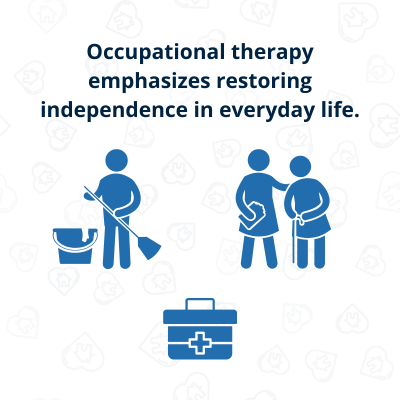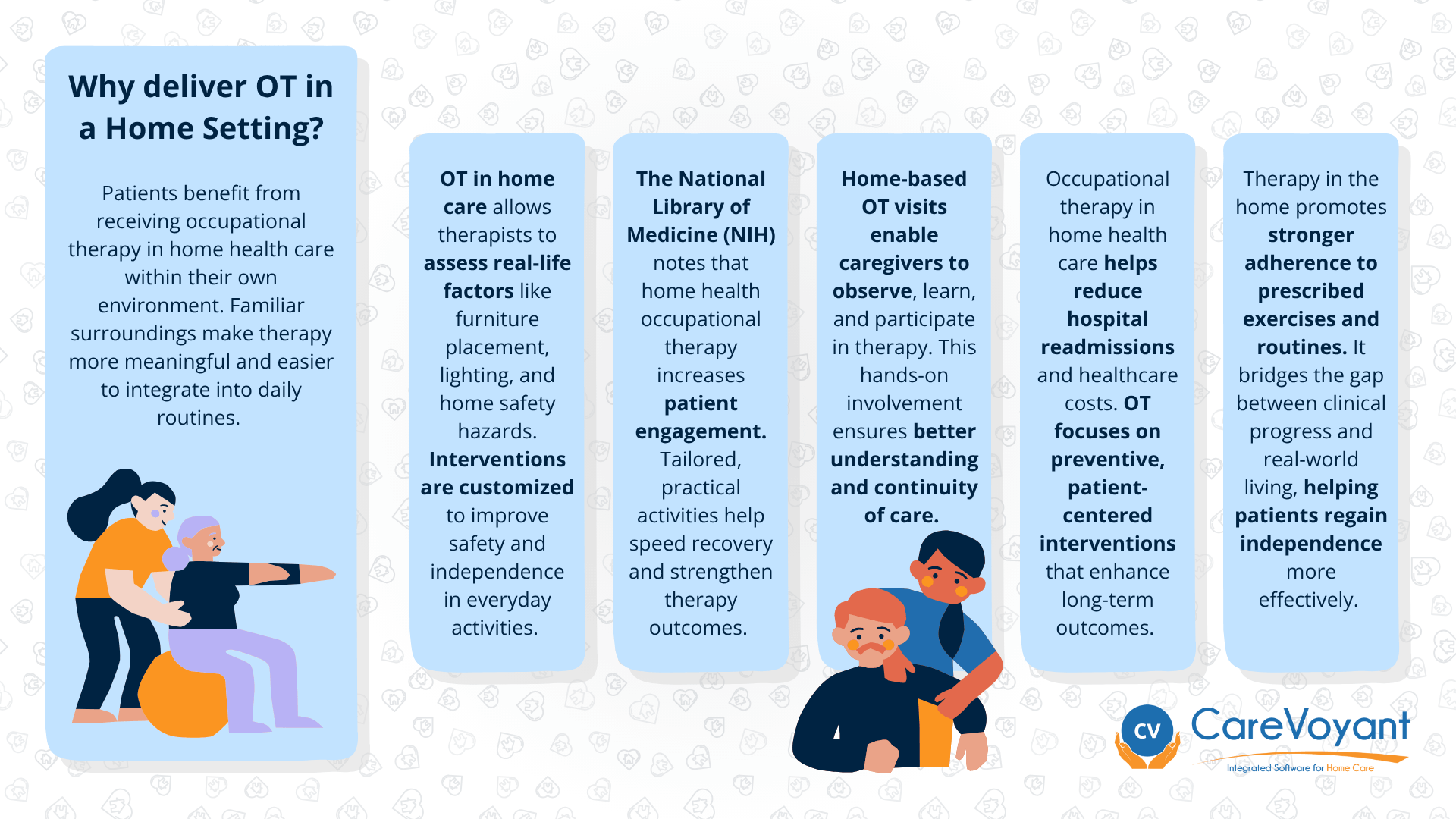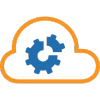Occupational therapy in home health care helps patients regain independence and safety at home after hospitalization. Integrating OT with strong care coordination and home health software improves outcomes, reduces readmissions, and supports value-based care success.
Introduction
After a hospital stay, many home health patients struggle to regain independence. Simple tasks like bathing, dressing, or cooking can become daunting, increasing the risk of hospital readmission. According to the National Institutes of Health (NIH), such functional decline significantly impacts recovery outcomes. This is where occupational therapy in home health care plays a vital role. Occupational therapists help patients rebuild daily living skills in the comfort of their own homes.
This article explores the benefits of occupational therapy in home health, and how agencies and home health software for therapy can work together to maximize outcomes and operational efficiency.
What is Occupational Therapy in Home Health?
Occupational therapy in home health care focuses on helping patients regain the ability to perform meaningful daily activities in their own living environments. Unlike outpatient therapy, where sessions occur in clinics or physical therapy, which primarily targets movement and strength, occupational therapy emphasizes restoring independence in everyday life. According to the U.S. Department of Health & Human Services (HHS), this includes assessing and improving Activities of Daily Living (ADLs) such as dressing, bathing, and eating, as well as Instrumental ADLs (IADLs) like meal preparation, medication management, and housekeeping.
Occupational therapists (OTRs) and certified occupational therapy assistants (COTAs) deliver these services in coordination with the home health agency’s interdisciplinary team including nurses, physical therapists, and case managers. They also assess the home environment for safety risks, provide adaptive equipment recommendations, and address cognitive and psychosocial challenges that impact function.
Under Medicare’s home health benefit, OT becomes part of the patient’s plan of care (POC) once skilled need and homebound status are established. What makes OT unique is its holistic approach, blending physical rehabilitation with environmental and emotional support to help patients safely live and thrive at home.
Why Deliver Occupational Therapy in a Home Setting?
Occupational therapy delivered in the home setting offers unique advantages that clinic-based care cannot replicate. The following benefits highlight why home-based OT is more effective, personalized, and impactful for patient recovery.
Comfort & Familiarity in Care
Patients benefit from receiving occupational therapy in home health care within their own environment.
Familiar surroundings make therapy more meaningful and easier to integrate into daily routines.
Personalized & Real-World Interventions
OT in home care allows therapists to assess real-life factors like furniture placement, lighting, and home safety hazards.
Interventions are customized to improve safety, functionality, and independence in everyday activities.
Improved Engagement & Recovery
The National Library of Medicine (NIH) notes that home health occupational therapy increases patient engagement.
Tailored, practical activities help speed recovery and strengthen therapy outcomes.
Active Family & Caregiver Participation
Home-based OT visits enable caregivers to observe, learn, and participate in therapy.
This hands-on involvement ensures better understanding and continuity of care.
Supports Value-Based & Preventive Care
Occupational therapy in home health care helps reduce hospital readmissions and healthcare costs.
Focuses on preventive, patient-centered interventions that enhance long-term outcomes.
Better Adherence & Functional Independence
Therapy in the home promotes stronger adherence to prescribed exercises and routines.
Bridges the gap between clinical progress and real-world living, helping patients regain independence more effectively.
How Home Health Software Supports OT Success
Delivering occupational therapy in home health care requires precision, coordination, and compliance. CareVoyant Home Health Software helps agencies streamline workflows, enhance patient outcomes, and reduce administrative burden allowing occupational therapists (OTRs) and certified occupational therapy assistants (COTAs) to focus on meaningful care. Here’s how software supports OT teams at every stage:
1. Streamlining OT Workflows
Integrated home health software centralizes all clinical, administrative, and financial operations under a single patient record. Therapists gain quick access to the patient’s plan of care (POC), physician orders, and interdisciplinary notes.
Intake & Authorization Management: Simplifies referral review, verifies eligibility, and sets up authorizations efficiently.
Plan of Care Alignment: Helps therapists ensure therapy goals are integrated into the broader patient care plan.
Scheduling Coordination: Rule-based scheduling allows OTs to coordinate visits alongside nurses and physical therapists, preventing overlap and maintaining continuity.
Integration with Electronic Visit Verification (EVV) and mobile platforms ensures accurate real-time visit capture for regulatory compliance.
2. Enhancing Clinical Documentation
Accurate documentation is essential for demonstrating therapy effectiveness and compliance with home health regulations.
Mobile Point-of-Care Documentation: Enables therapists to record interventions, progress, and patient education during or immediately after visits.
Built-in Templates & Assessment Forms: Standardized ADL/IADL evaluation tools simplify compliance with OASIS, therapy templates, and home safety assessments save time while ensuring regulatory compliance.
Medication and Treatment Tracking: Features like eMAR/eTAR allow therapists to monitor medications and potential side effects that may impact functional performance.
This reduces duplicate data entry and enhances communication across the interdisciplinary care team.
3. Facilitating Care Coordination and Communication
Strong interdisciplinary collaboration improves patient outcomes and adherence to therapy plans.
Centralized Communication Hub: Messages, alerts, and notes are stored in one location, keeping OTs, nurses, and case managers aligned.
Caregiver Engagement Tools: Enables sharing of therapy goals and strategies with family members to reinforce interventions at home.
4. Tracking Outcomes and Measuring Quality
Outcome measurement is crucial for demonstrating the value of occupational therapy in home health care.
Real-Time Analytics: Reports and dashboards track patient progress, therapy outcomes, and visit frequency.
Clinical Quality Metrics: Monitor improvements in ADLs, fall risk reduction, and hospital readmissions.
Operational Efficiency Insights: Administrators can evaluate therapist productivity, resource utilization, and compliance trends for continuous improvement.
5. Supporting Financial and Operational Integration
Occupational therapy is both a patient care and revenue-driving service. Integrated software ensures accurate billing and operational transparency.
Billing & Revenue Cycle Management: Therapy visit data flows directly into billing workflows, reducing errors and claim denials.
Payroll & Accounting Integration: Tracks therapist hours and visits accurately, minimizing administrative burden.
Data-Driven Decision Making: Financial and operational analytics help agencies optimize workflows and allocate resources efficiently.
By breaking down workflows, documentation, care coordination, outcome tracking, and financial integration into clear steps, home health software allows OT teams to focus on patient-centered care while improving efficiency, compliance, and agency performance.
Conclusion
Occupational therapy in home health care plays a vital role in helping patients regain independence, safety, and confidence where it matters most - their own homes. By addressing functional challenges, reducing fall risks, and promoting engagement in meaningful activities, in-home OT supports faster recovery and improved home health therapy outcomes.
To maximize these benefits, agencies should take actionable steps:
Identify patients who will benefit most from OT through targeted screening.
Integrate OT goals into the broader plan of care for seamless interdisciplinary collaboration.
Leverage CareVoyant Home Health Software to streamline documentation, ensure compliance, and track therapy progress.
Engage caregivers to reinforce therapy techniques and sustain gains between visits.
Prioritizing OT within your clinical strategy not only enhances patient outcomes but also strengthens your agency’s performance under value-based care models, reducing readmissions, improving star ratings, and increasing operational efficiency.
Empower your therapy team with technology that supports excellence in care. Learn how CareVoyant Home Health Software helps home health agencies streamline OT workflows, improve outcomes, and deliver quality patient-centered care.
Frequently Asked Questions
-
Occupational therapy in home health care helps patients recover independence and perform Activities of Daily Living (ADLs) safely at home after illness or hospitalization. Therapists assess functional needs, home safety, and provide ADLs assistance to improve overall quality of life.
-
Unlike clinic-based sessions, home health occupational therapy takes place in the patient’s own environment. This allows OTs to assess real-life factors like lighting, furniture placement, and mobility hazards and create personalized interventions for greater therapy outcomes.
-
Patients typically qualify if they are homebound, under a physician’s care, and require skilled therapy. Medicare and other payers cover OT in home care when there is a medical necessity to restore or maintain functional independence in the home setting.
-
Home health occupational therapy benefits include improved functional independence, reduced fall risks, enhanced home safety, and prevention of hospital readmissions. OT interventions also support patient engagement and caregiver education for lasting recovery at home.
-
By addressing mobility limitations, home hazards, and medication management, OT helps patients recover safely. These preventive, functional interventions reduce the likelihood of falls and complications key factors in lowering readmission rates under value-based care models.
-
Caregivers support OT in home care by observing therapy sessions, learning adaptive strategies, and reinforcing exercises between visits. This active involvement promotes adherence, consistency, and better therapy outcomes for patients.
-
Patients recovering from stroke, surgery, cardiac events, or neurological disorders gain the most from OT in home care. Occupational therapy interventions in the home for older adults also address age-related functional decline, ensuring safer and more independent living.
-
Integrated home health software streamlines documentation, scheduling, and care coordination for OTs and COTAs. By managing therapy workflows, tracking ADL progress, and aligning plan of care, it enhances clinical efficiency and ensures compliance with regulations.
-
OTs use home health software to document interventions, share progress notes, and communicate with interdisciplinary teams. This seamless integration of therapy data supports real-time updates, quality tracking, and data-driven decision-making for improved patient outcomes.
-
Agencies can use unified home health software to connect care teams, automate OT documentation, and analyze therapy outcomes. This improves efficiency, reduces administrative burden, and enhances both patient satisfaction and agency performance.
About CareVoyant
CareVoyant is a leading provider of cloud-based integrated enterprise-scale home health care software that can support all home-based services under ONE Software, ONE Patient, and ONE Employee, making it a Single System of Record. We support all home based services, including Home Care, Private Duty Nursing, Private Duty Non-Medical, Home and Community Based Services (HCBS), Home Health, Pediatric Home Care, and Outpatient Therapy at Home.
CareVoyant functions – Intake, Authorization Management, Scheduling, Clinical with Mobile options, eMAR/eTAR, Electronic Visit Verification (EVV), Billing/AR, Secure Messaging, Notification, Reporting, and Dashboards – streamline workflow, meet regulatory requirements, improve quality of care, optimize reimbursement, improve operational efficiency and agency bottom line.
For more information, please visit CareVoyant.com or call us at 1-888-463-6797.
Request for Information
To learn more about CareVoyant Software and how we improve the operational efficiency of Home Healthcare Agencies, contact us:
















